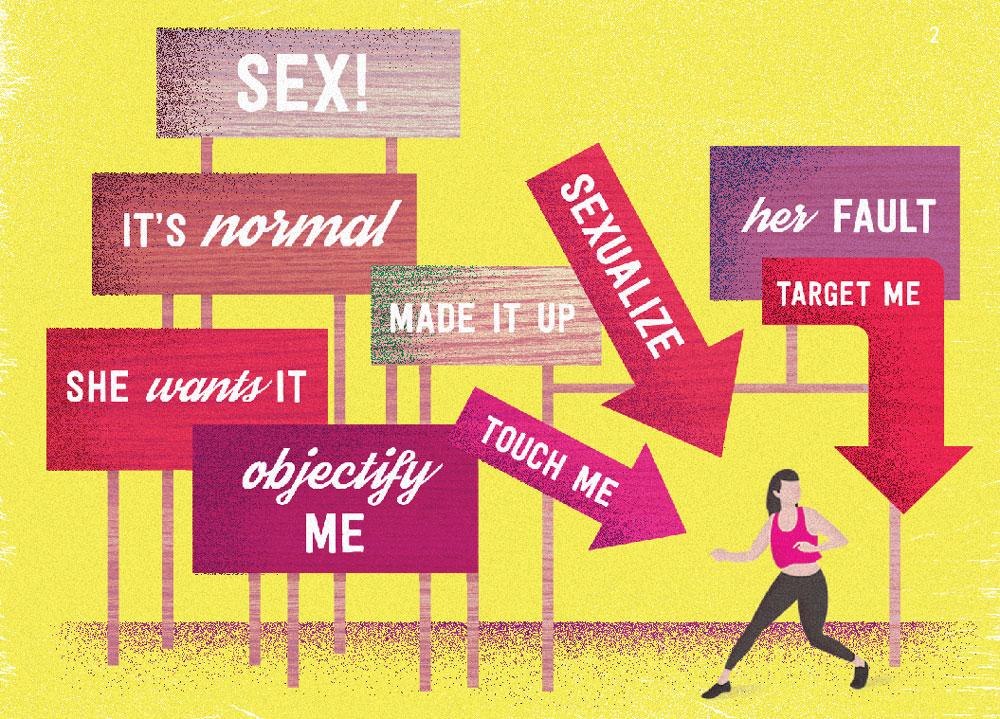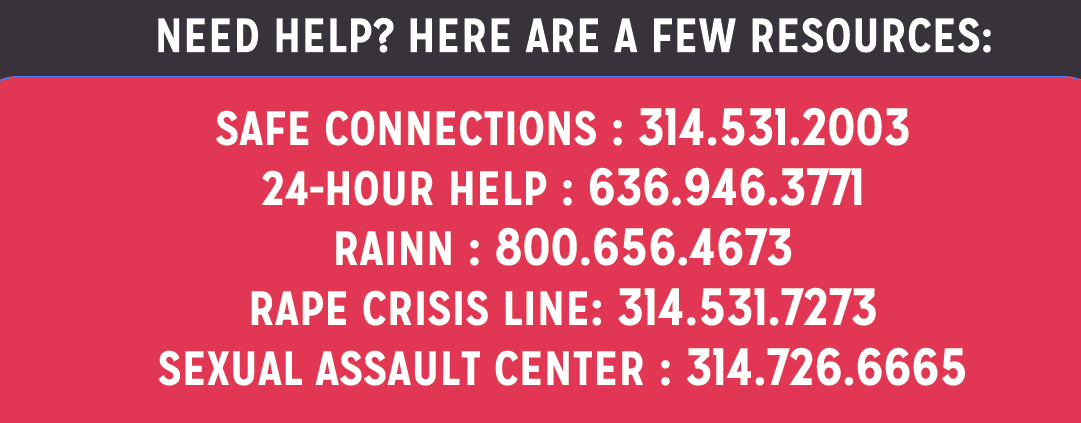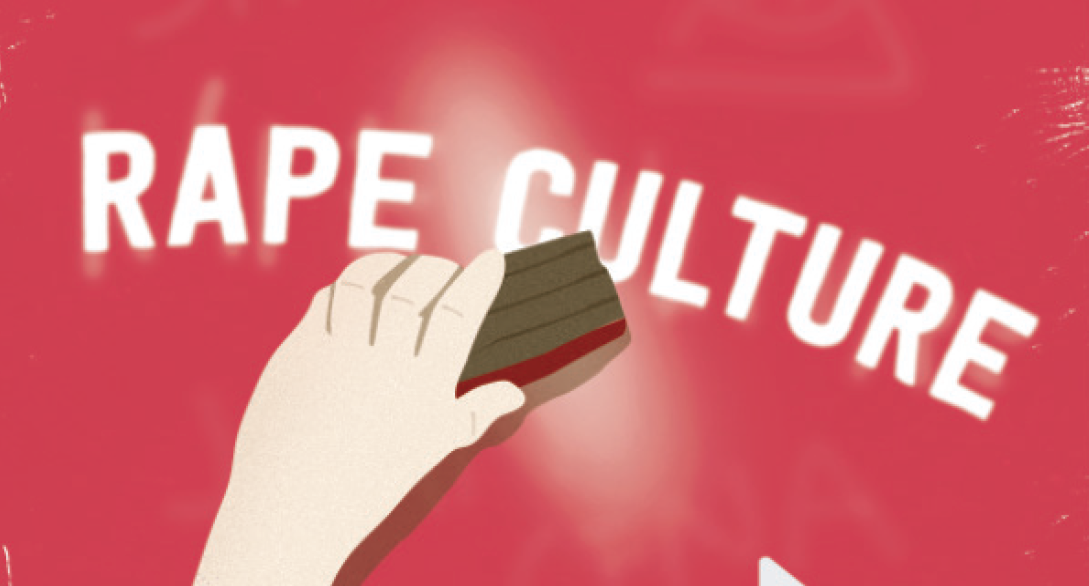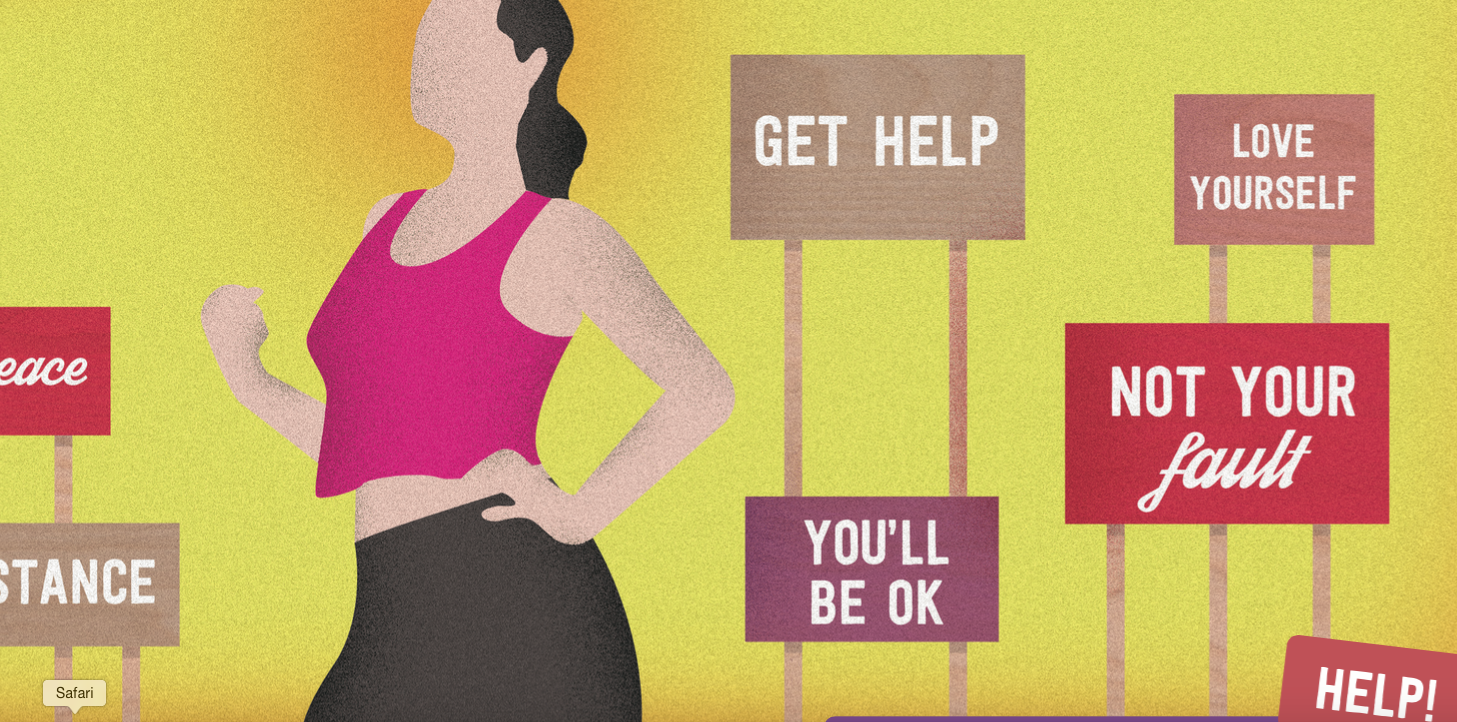Your donation will support the student journalists of Francis Howell North High School. Your contribution will allow us to purchase equipment and cover our annual website hosting costs.
Rape Culture in Twenty First Century Society
Published: February 11, 2016
Most of us have talked about rape–what it is, why it happens or why it’s wrong. Some may even know someone who has been a victim of rape. It’s a serious topic, yet in today’s society, it has become normalized through jokes and media. It’s treated as a punchline, a plot device, an edgy lyric. This lack of sensitivity is known as “rape culture.” Society often blames victims, both men and women for getting raped–for what they were wearing, what they were doing or where they were. But what we must realize is that rape is no one’s fault but the offender’s. and it’s far from a trivial matter.

It’s No Laughing Matter
In today’s society, rape is often joked about and not taken seriously, desensitizing the real issue.
Sex without consent is no joke, though students can often hear the casual use of the word “rape” float through the hallways. Turn on the TV and one might find the latest “Game of Thrones” episode on, airing yet another rape scene. Many of the artists behind today’s hits have lyrics that often degrade women, portraying them as sexual objects. Together, these factors contribute to what is referred to in our society as rape culture.
“Rape culture is increasingly normal,” Scarlett Peterson, former leader and alumni of the Sex and Body Positivity Committee at Kennesaw State University said. “It’s always been there, especially in patriarchal societies.”
Rape culture affects both genders, however bias against women tends to be more common. It is easy for males to blame a victim of rape or assault and tarnish their image, however in many cases, such charges can be dismissed. Because men are not affected as frequently, it can make it difficult for them to be aware of rape culture. Women are sexualized and stigmatized.
Female victims may find it difficult to report claims of sexual assault because they are often blamed because of how they dressed or how much they had to drink during the account of the assault. However, because rape is generally perceived as something that only happens to women, men who are raped are often dismissed, shamed or invalidated as well.
“Rape culture doesn’t really give males the chance to speak up and say that this is not the norm,” sociology professor at St. Charles Community College, Vicky Herbel, said.
It’s often said that the entertainment industry plays a large role in condoning rape. “Blurred Lines”, a popular song from 2013 by Robin Thicke, is one of many songs that includes lyrics with derogatory phrases towards women, suggesting that there is a gray area between consensual sex and rape. Rape jokes are found often in the television sitcom “2 Broke Girls,” and the use of rape as a lighthearted joke is what promotes the attitudes of rape culture, according to Herbel.
“The joke you make is the experience of someone else,” Herbel said.
Social media platforms like Twitter and FaceBook gives people a medium to promote rape culture. The nature of social media makes it easy for anyone, from a high schooler to an adult, to make rape jokes or blame the victims of sexual assault because all interaction on social media is indirect. While the dress code is enforced in many schools to create a safe and disciplined learning environment, unequal or unfair enforcement also has the potential to condone rape culture by telling women that their bodies are more important than their education. Because of rape culture’s prevalence, wherever there is a social setting, rape culture is likely to manifest in various forms.
“Many people promote rape culture without realizing what they’ve done,” Peterson said.
When the ideologies of rape culture are seen everywhere in people’s daily lives and on social media, they lose sensitivity to the severity of the topic of rape, which is a major component of rape culture. For example, people may find it normal for a Super Bowl advertisement for a fast food chain to feature a very sexualized woman. This advertising tactic takes advantage of the objectification of women as a device to encourage sales. Ads by companies like Gucci and Prada also include the objectification of both men and women.
“The victims who came forward during the Bill Cosby scandal were typically dismissed because he was seen as the father of television and a good role model,” Peterson said.
Even those who are advocates against rape culture may occasionally promote it unintentionally. Because rape culture is so internalized, it makes it hard to stop since the thoughts people have seem so normal, even if they have harmful implications that they don’t recognize.
“People subconsciously promote rape culture,” Herbel said. “You may sing along to a song that contains lyrics that promote rape culture. It’s hard to escape, but important to be critical of it.”
Although progress has been made with bringing about awareness of the spread of rape culture and the seriousness of sexual assault, there is still much to be done. According to Herbel, the conversation of sexual violence is a lot more prevalent than it used to be, but the movement against rape culture is not yet strong enough to halt it. Peterson suggests that keeping the conversation of rape culture going and letting those who make jokes know that the jokes are not acceptable can help challenge the normalization of rape.
“By making rape culture part of the daily conversation, it will make people more aware of the seriousness of rape,” Herbel said.

Dress Code Concerns Start in Middle School
Starting as early as elementary and middle school, the dress code, a set of rules about what clothing can and can’t be worn at school, is enforced by teachers and administrators onto students. According to the National Center for Educational Statistics, approximately 49.1 percent of public schools have a “strict” dress code policy.
“I think a dress code is important,” Birch said. “As an administrator and someone who handles discipline on a regular basis, I don’t feel like we devote a lot of time to disciplining or having those conversations with kids because of the dress code. Certainly, in the whole scheme of things, sure, we have conversations with students about it, but it doesn’t take up a lot of our time. It’s not something that’s overwhelming.”
In today’s society, when someone is raped, many people assume it was the victim’s fault for getting raped. This is called victim blaming: when a victim’s choices, including what they were wearing, whether they were drinking or what they were doing, are used to justify an attackers actions.
“The worst part about victim blaming is the impact it has on the victim,” Assistant Principal Chris Birch said. “They’re already a victim of whatever crime and are going through a lot. I think that if they’re being wrongfully blamed or others are judging, and the victim knows they’re judging, it can be very painful, and it certainly doesn’t help.”
The reason the dress code’s written the way it is, I think, is to encourage people to respect themselves.
— Alan Beeson
Many people believe the dress code contributes to the sexualization of men and women, due to the age of the students that it’s enforced upon, and then later to victim blaming. Other people believe dress codes serve their one specific purpose: minimize distraction in the learning environment.
“The reason the dress code’s written the way it is, I think, is to encourage people to respect themselves, and what’s considered appropriate in a professional environment,” Hollenbeck English teacher Alan Beeson said. “The idea is to have some respect for the learning environment. If people are taking that to mean ‘Hey, if you dress like that, you’re gonna get raped,’ I don’t think that’s the intention at all. Traditionally, it’s a sign of respect, not hanging out of your clothes out of respect. If the message people are taking away from it is that we’re saying don’t dress like this or else this will happen to you, I think the message should be clarified.”
While the dress code in schools are intended to keep distractions out of the learning environment, some people believe that it does nothing besides promote the sexualization of children, typically girls. Others believe girls get in trouble for what they wear more often than boys because of the way style is today. The style for girls is typically shorter shorts and lower cut tops, while the style for boys isn’t nearly as revealing.
“I think in some respects, the dress code is harsher on girls because of style,” eighth grade science teacher Michelle Oppenborn said. “I know, having a daughter, it was difficult to find shorts that were long enough. I think some girls are trying to be fashionable, and I think in that they run into spaghetti straps and lower cut shirts.”
Students typically don’t have any conflict with the school dress code until they reach the middle school level, which is the age that sexualization of others typically begins, due to puberty. Middle schools work to prevent any type of sexual assault by having speakers from organizations such as the Crider, a health center, come in and discuss the importance of abstinence.

The Elephant In the Room
Rape. It’s just four letters, one word, with no synonym that packs the same punch. Written down on paper, there’s very little confusion as to what those four letters mean, and by high school, most students know why the word rape carries the resounding power that it does. And most students know that rape is not okay.
“Rape would be a criminal offense,” counselor Mary Kerr-Grant said. “If a student came and said ‘I was raped on the premises,’ I would immediately contact the police.”
At FHN, Freshman Health teachers Jenelle Louis-Bauer and Chris Brown bring in Resource Officer Sarah Brueggeman and Lauren Klepac, a victim advocate from the St. Charles Prosecuting Attorney’s Office, to discuss the importance of consent and the legal implications of sexual assault. Due to mandatory reporting laws and Title IX, a federal law that prohibits discrimination on the basis of sex in schools, schools must have protocols in place for handling reports of sexual abuse.
“Our building is really, really strong if a student comes with a sexual harassment claim,” Kerr-Grant said.
Rape culture. It’s just two words, three syllables, 11 letters. Despite the extra characters, rape culture is a topic that is rarely talked about and is much harder to recognize. But rape culture is a silent killer – the influence it has on society is subtle, but the effects it has are just as dangerous as rape itself.
“It’s not a conversation a lot of people want to have,” Freshman Health teacher Chris Brown said. “Parents don’t want to have it, and teachers are nervous about bringing it up in class, for fear of people not taking it seriously or teachers [not] being able to talk freely without some parent or administrator getting upset about something that can be so controversial.”
The conversation about rape culture is often accompanied by confusion. While the phrase has had a growing presence on social media over the past few years, the definition is sometimes still blurred and unstable. But rape and rape culture have two different meanings. Rape culture encompasses the normalization of rape, that it’s okay to promote sexualized violence on TV and in video games, that victims are the one to blame for what happens to them.
However, rape culture is a social issue that goes mainly unaddressed in schools. Rape jokes are still a prevalent form of humor amongst teenagers, unrealistic beauty standards still dominate Twitter and Facebook feeds, and many students have experienced the effects of dress codes at one point or another.
“They’re quiet [when discussing rape culture],” Louis-Bauer said. “I think a lot of [students] see it, and when they really start to recognize it, I think it scares them.”
The phrase itself carries a lot of prejudice. Some people are hesitant using it due to some of its isolating connotations. Elisabeth Condon, an FHN graduate and the Sexual Assault Prevention Committee Chair in Truman State University’s Student Government, tries to avoid using the term rape culture, as some believe that it excludes the idea that men can be victims.
“[Rape culture] tends to be alienating for male victims,” Condon said. “Men can also be affected. [The committee] tries to proliferate that rape can happen to anybody.”
At Truman State University, the Sexual Assault Prevention Committee is working on updating posters and information around the school so that students know how to report instances of sexual abuse and where they can find help. FHN used to hold a presentation to raise awareness for sexual assault, including a video on dating violence, for the junior class, but last year was the first year that it wasn’t held since the video seemed too outdated to use.
Without any discussion about rape culture at school, students won’t be taught to recognize the problems in advertising, television and pop culture that perpetuate the normalization of rape. Those 11 letters should carry the same punch as the first four, but without any attention, the term risks getting lost and ignored by society.
“It’s important to educate people about it,” Kerr-Grant said. “I think a lot of people don’t think twice about it but it’s there.”

Hard to Realize, Harder to Forget
The summer following her freshman year was, for Sarah*, the beginning of something beautiful. Until it wasn’t. At the age of 14, she entered an eight-month relationship in which she was emotionally blackmailed, abused and raped multiple times. It took until after her relationship had ended to realize what she had experienced was rape.
“It was an emotionally abusive relationship, and I was raped a number of times,” Sarah said. “A lot of people will say that I consented to have sex, whether or not it was on my own terms, because I was in a relationship. Even I, at first, didn’t identify it as rape. But as I came to terms with what happened and was able to identify it as what it was, I realized that I wasn’t the one with the problem in the situation.”
In the time following the end of the relationship, Sarah faced problems with both mental illness and stalking by her rapist, which amounted to both depression and revelation. She was eventually admitted to a hospital for a suicide attempt, and in the self-care and therapy that followed, the true impact of what she had experienced came to light.
“Once you learn how to take care of yourself, you can look back and say ‘that wasn’t what that should’ve looked like,’” Sarah said. “Coming to terms with the fact that what happened to me was abuse and was rape was a really long process in general. In the couple of months that it took me to realize that, I just hated myself, because I blamed myself for every bit of it, and there was nothing in me that said that I shouldn’t.”
In society today, there is stigma surrounding women who open up about sexual abuse or assault – a stigma that Sarah is no stranger to. It comes in the form of victim-blaming, refusal to believe victims’ stories, insistence that victims either “asked for it” or enjoyed it and a number of other forms. In some cases, this hostility towards survivors of sexual abuse and/or assault may even become internalized, which can wreak havoc on recovery and coping.
“Survivors have always had my greatest sympathies, because there’s really not much worse you can go through,” Sarah said. “And then to have it not believed or to be blamed for it yourself is just awful. Logically, I know that it’s not my fault, because it’s never the victim’s fault. It’s easy to blame me and say I should’ve been smarter. It’s also easy to look at him and say you shouldn’t rape people, and that’s the right approach to take.”
Despite the fact that years have passed since the relationship ended, Sarah still faces problems brought upon her by her experience. She is uncomfortable with physical touch, especially without warning or permission, and always feels hyper-aware of her surroundings and the people around her. According to her, saying and hearing the word “rape” makes her physically uncomfortable, and rape jokes have taken on a new edge of seriousness.
“It’s kind of a human quality, where tragic things happen and we joke about them, and that’s how we cope,” Sarah said. “But I think as people talk about it more and more, the word becomes misused more and more frequently. The word has become so commonly used that people don’t realize how serious it is. It’s not one of those words with a visceral reaction attached anymore. It’s a real thing that happens, and it should make people uncomfortable, because that’s not something that should be normalized.”
She believes that there is a solution to the normalization and trivialization of rape, or “rape culture,” and that is simply seeing rape for what it is – a violation and something that isn’t to be normalized – and having a little empathy for others, regardless of who they are or what they’ve been through.
“I think a little bit of empathy never hurt anyone,” she said. “I think that that’s something we’re very much lacking. Everything has turned into a political statement, or something self-serving. I think that if we as people were more empathetic, we’d be able to empathize with survivors, we would believe them more, and we wouldn’t blame them, so survivors would have a much easier time. And honestly, if you empathize with someone, I don’t know that you could rape them.”
As time goes by, Sarah finds herself making peace with what happened to her, and chooses to look at what she’s learned. She now uses her experience to help others in similar situations when she can. She still faces days where she blames herself for what happened, or cannot stand any physical contact, but they are growing less and less common.
“Honestly, every day it’s becoming a little easier to distance myself from it,” Sarah said. “I’m very proud of myself. I’m still recovering, and I’ll still have days where I can’t be touched, and I sit around blaming myself, but it’s once in a blue moon at this point. And I know that eventually those days are going to go away entirely – I’ll still have bad days, but they won’t be like that. I’m very much looking forward to a time where I can be completely healed.”
*a pseudonym is used for privacy purposes



